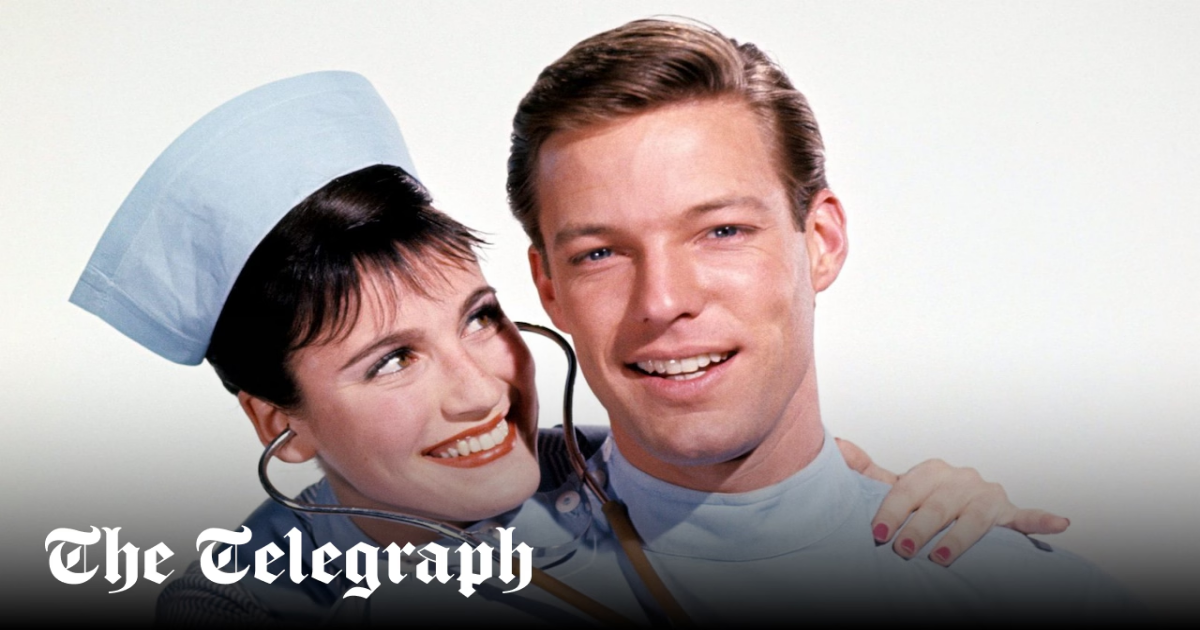Richard Chamberlain, the American actor who has died aged 90, made his name in the title role of Dr Kildare, the long-running 1960s television series, and had trouble shaking off the part’s whiter-than-white image.
Part of the trouble was that Chamberlain – tall, blond, clean-cut – was really too pretty for his own good as an actor. He tried hard to prove himself in serious roles, flying in from Hollywood to essay Hamlet at the Birmingham Rep; but it was somehow characteristic of his career that even in his forties he was cast as Prince Charming in Bryan Forbes’s sugary film of the Cinderella story, The Slipper and the Rose.
Shown on the BBC between 1962 and 1966, Dr Kildare featured the baby-faced Chamberlain as a sensitive young hospital medic. Based on a Hollywood film character from the 1940s, the part made him an instant heart-throb. Chamberlain even made it into the pop charts with a vocal version of the theme song.
But his biggest dramatic parts in feature films, as Tchaikovsky in Ken Russell’s The Music Lovers and Lord Byron in Lady Caroline Lamb (opposite Sarah Miles) in the 1970s, turned out to be something of an embarrassment. And although he continued in his efforts to tackle classical roles, such as Cyrano de Bergerac and Richard II, Chamberlain became best known as the star of the hugely successful, if artistically dire, television mini-series The Thorn Birds and Shogun.

In The Thorn Birds, as the tortured priest who fights off the lustful attentions of the aged Barbara Stanwyck and the nubile Rachel Ward to end up as an absurdly well-preserved cardinal in Rome, Chamberlain enraptured a new generation of admirers — though the heart-throb himself did not look a day older than when he had played James Kildare. Screened on BBC One in 1984, the series suffered for being programmed against The Jewel in the Crown on ITV.
Cynics tended to the view that Chamberlain’s longings to be taken seriously as an actor would have carried more conviction if he had chosen to let nature take its course as far as the ageing process was concerned. The blunt truth is that many of his performances were painfully wooden, but two in particular made a powerful impression which lingers in the memory.
The first was a sensitive and moving account of the consumptive (and supposedly ugly) Ralph Touchett in the BBC Two classic serial adaptation of Henry James’s Portrait of a Lady; the second a searing study of a vicious, rich, spoilt and impotent Californian “pretty boy” who beats up his wife (played by the British actress Julie Christie) in Richard Lester’s underrated film Petulia (1968).

A bewitched Chamberlain considered his leading lady the most beautiful woman he had ever set eyes on, and her British boyfriend almost as beautiful. Their encounter prompted Chamberlain to move to London, where he remained for nearly five years. When Peter Dews, artistic director of the Birmingham Repertory Company, saw him on television in Portrait of a Lady, he persuaded Chamberlain to play Hamlet, a role in which he finally graduated from matinee idol to actor, and found himself taken seriously.
The performance was praised in some quarters for its unconventional interpretation of Hamlet as “an open-hearted natural extrovert who for the first time in his life is confronted by an insuperably difficult moral problem”.
Chamberlain relished his time in the UK, not least on account of his regard for the British aristocracy, squiring Princess Margaret, much to the irritation of Lord Snowdon, and taking tea with the Duke and Duchess of Bedford at Woburn Abbey. He also hobnobbed with theatrical royalty, and credited Sir Cedric Hardwicke with expediting his move to London by telling him that as Dr Kildare, Chamberlain had become a star before having had a chance to learn to act.
In his memoir Shattered Love (2003), Chamberlain confessed that he had always thought of himself as a character actor in leading-man clothing. “The care and protection of my partly fabricated public persona became a built-in, habitual part of myself,” he wrote, “along with the fear of exposure that I worried might stop my career cold.” Outed as gay by a French magazine in 1989, he only confirmed it more than a decade later, when he was almost 70.

The younger of two brothers, George Richard Chamberlain was born in Los Angeles, California, on March 31 1934, the son of an alcoholic supermarket fixture manufacturer. He was educated at Beverly Hills High School, where he starred in a student production of The Pied Piper of Hamelin, and Pomona College, Claremont, California, where he studied art and acted in plays, notably as Captain Bluntschli in Shaw’s Arms and the Man. As a neurotic adolescent, he had dated girls but, realising he was gay, confessed himself stricken by “sexual dismay”.
He undertook his National Service with the US Army in Korea as a company clerk, attaining the rank of staff sergeant. On returning to Los Angeles in 1958, he had his first affair with another man, and took a series of odd jobs, including chauffeur, supermarket clerk and construction worker, to pay for acting classes.
The next year he landed his first professional job as an actor, a bit-part in an episode of the television cowboy series Gunsmoke, and soon afterwards appeared in the feature films The Secret of the Purple Reef and A Thunder of Drums, earning a seven-year contract with MGM.

When the studio decided to create a television series based on the popular Dr Kildare films of the 1940s, Chamberlain, at 24 but looking younger, was among the dozens of actors tested for the pivotal role of the idealistic medical intern.
Although his first reading was by all accounts, a little colourless, the show’s producer saw in the actor “a great warmth and personal charm”; and perhaps more important, the veteran Canadian actor Raymond Massey, slated to play Kildare’s mentor, Dr Gillespie, found him “compatible”.
From its US debut in 1961 to its demise five years later, Dr Kildare was among the most watched programmes on television. It focused on the emotive aspects of the practice of medicine, tending to gloss over the starkness of its clinical side.
A gentle, selfless and warm-hearted man, dedicated to the well-being of his patients, James Kildare was described by Chamberlain himself as a “prig” and “an irreclaimable bore”. But the role won Chamberlain extraordinary popularity. Fan mail poured in from around the world, a record 12,000 letters a week.
“It was agony talking to the press,” he later recalled, “because I could never speak my mind – I always had to say that everything was lovely and beautiful and true. Even my reactions to life became stereotyped because of Kildare’s.”

In an effort to extend his range, Chamberlain continued his professional training throughout Dr Kildare’s five seasons and branched out as a singer, recording the album Richard Chamberlain Sings, which became a modest hit.
When Dr Kildare, a victim of dwindling ratings, finally ended, Chamberlain decided to focus his attention on the theatre. In 1966 he made his New York stage debut in Breakfast at Tiffany’s opposite Mary Tyler Moore, but the show closed during the previews.
Invited to London in 1967 for a guest spot on Eamonn Andrews’s television chat show, Chamberlain was introduced to his hero Noël Coward, and decided to remain in England for “any kind of training I could find”. His performance in a six-hour television adaptation of The Portrait of a Lady attracted Royal approval. “Oh yes, we watched that,” the Queen told him when he was introduced at a film première, adding: “Well, not all of it.”
During Chamberlain’s time in Europe, his screen credits included a young French radical in The Madwoman of Chaillot (1969), Bryan Forbes’s star-studded version of Jean Giraudoux’s fragile, stylised fantasy; and Octavius in a production of Julius Caesar (1971), with Charlton Heston.

On his return to America Chamberlain played Richard II for the Seattle Repertory Theatre and again in a new production of the play, staged by Jonathan Miller, for the Center Theatre Group at the Ahmanson Theatre in Los Angeles.
In 1972 he became the first American to star in a production at the Chichester Festival in Britain when he took the part of Thomas Mendip, an itinerant soldier in 15th-century England, in Christopher Fry’s The Lady’s Not for Burning. The next year he tackled Cyrano de Bergerac in Los Angeles.
Throughout the 1970s Chamberlain interspersed his stage assignments with film and television appearances – including as the dashing Aramis in Richard Lester’s leadenly facetious remake of The Three Musketeers (1973) and its sequel, The Four Musketeers (1975); and the disaster spectacles The Towering Inferno (1974) and The Swarm (1978).

A soft-spoken, introspective man who preferred to keep his private life “very private,” Chamberlain found it difficult to balance his professional and personal lives, and later underwent several years of what he called “psychological work”.
He divided his time between a Japanese-style home in Beverly Hills, a Manhattan apartment and a holiday hideaway on the island of Oahu, Hawaii. For many years he shared his life with the actor and producer Martin Rabbett. Although they split up in 2010, they remained friends.
Richard Chamberlain, born March 31 1934, died March 29 2025



